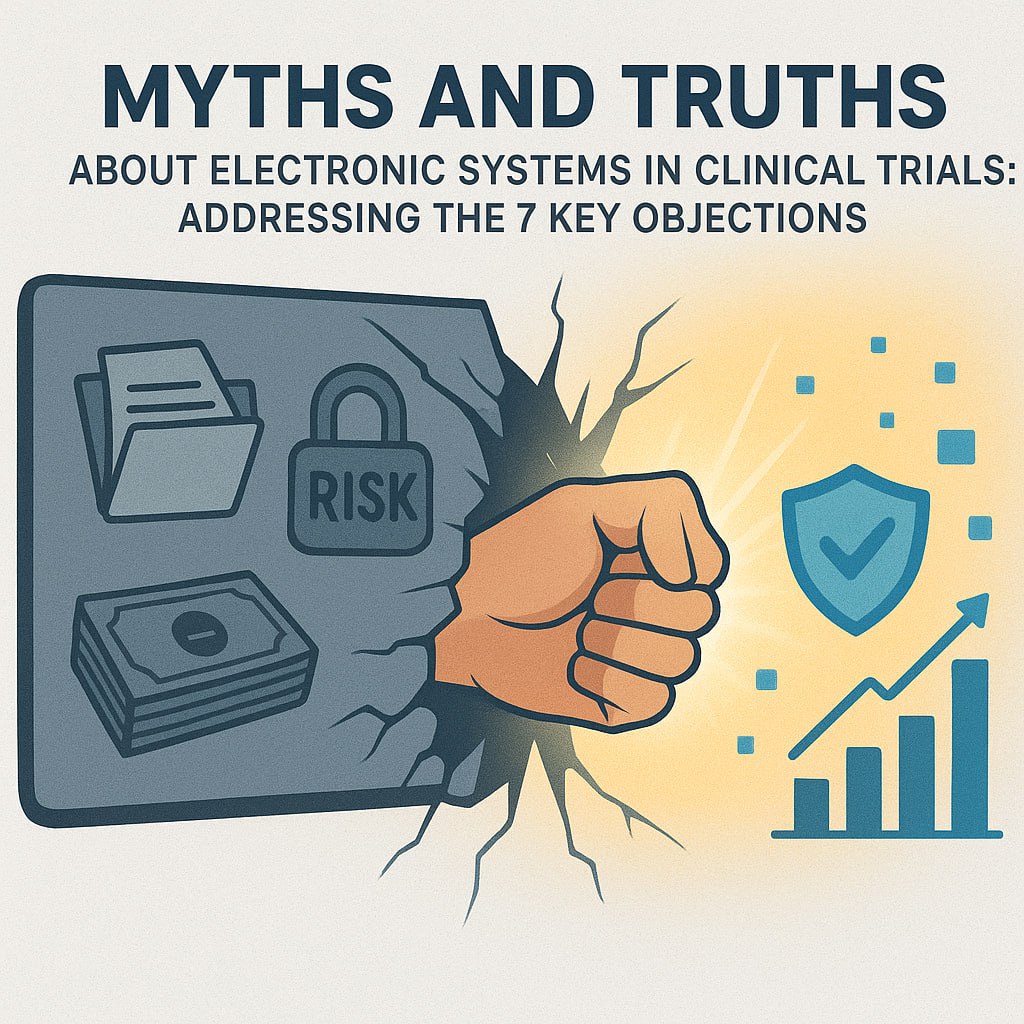The pharmaceutical and medical industries are undergoing a digital transformation, yet the adoption of modern electronic systems continues to face conservative biases. Many sponsors, CROs, and research centers mistakenly believe that traditional paper-based methods for data collection and management remain more reliable, secure, and cost-effective. This skepticism, based on outdated information, creates barriers to innovation and increases the cost of bringing new drugs to market.
In this article, we debunk 7 key myths using research data and expert assessments.
Myth:It's financially unfeasible for most studies
Truth:A Total Cost of Ownership (TCO) analysis demonstrates the opposite. Initial investments in Electronic Data Capture (EDC), electronic Trial Master File (eTMF), or Clinical Trial Management Systems (CTMS) pay for themselves within 12-18 months through:
- Reduced monitoring costs (up to 40-50%): Built-in checks and remote monitoring drastically reduce the number of expensive on-site monitor visits.
- Elimination of physical storage and logistics expenses: This includes costs for paper, printers, courier services, warehouse rental, and document handling staff.
- Minimized risks of regulatory non-compliance: Early error detection prevents costly delays during the regulatory submission phase.
- Faster time to clean database lock: Automated data clarification requests and real-time validation reduce the time to database lock by weeks or even months.
Myth:Implementation will take months and paralyze current projects
Truth:Modern platforms use a phased implementation approach:
- Pre-validated CRF templates: For standard study designs, most of the work is already done by the provider. You don't need to build forms from scratch.
- Standardized data migration protocols: Established processes ensure secure and fast transfer of historical data.
- Pilot project or first study phase launch is possible within 4-6 weeks. Implementation occurs in stages without disrupting operational processes.
Myth:Staff won't be able to adapt to complex interfaces
Truth:Intuitive interfaces with contextual hints reduce training time to 2-3 days, not weeks.
For example, modern systems, such as Chronicles clinical suite, utilize:
- Personalized dashboards: A site coordinator sees only their tasks, while a project manager sees the big picture across all centers.
- Real-time data visualization: Charts and graphs help quickly assess progress and identify trends without generating complex reports.
- Automated checks and reminders: The system itself prompts the user about missed visits, data discrepancies, or upcoming events.
- Comprehensive knowledge base: 24/7 support in a how-to format helps users resolve most issues independently.
Myth:Paper records are more reliable from a regulatory compliance standpoint
Truth:Electronic systems ensure full compliance with requirements:
- Every action has a digital signature and is precisely linked to the user who performed it.
- Data is entered into standardized fields, eliminating interpretation errors.
- Automatic timestamps record the exact time of each entry.
- The system retains the original entry and all subsequent changes in an audit trail, ensuring data authenticity.
- Built-in data validation at the point of entry prevents errors at the earliest stage.
Myth:Integration with existing IT infrastructure is impossible
Truth:Modern platforms are designed as open ecosystems. They:
- Enable integration with electronic health records, laboratory systems, and hospital management systems, eliminating double data entry.
- Facilitate data preparation for regulatory submissions.
- Ensure automatic synchronization between modules (EDC, CTMS, eTMF, IXRS): Changes in EDC are automatically reflected in CTMS and eTMF.
Myth:Cybersecurity poses an insurmountable risk
Truth:Professional providers ensure:
- International certifications ISO 27001 (information security) independent proof of reliability.
- End-to-end data encryption, regular backups.
- Compliance with data protection standards: Built-in GDPR-compliant mechanisms for managing patient consent and handling personal data.
Myth:Managing the systems will require expanding the IT team
Truth:Outsourcing technical support and training administrators through the provider drastically reduces the operational burden on internal resources. For example, comprehensive service offerings include:
- Dedicated 24/7 technical support in your native language.
- Remote updates and maintenance: You always work on the latest software version without downtime or upgrade costs.
- Training programs for administrators and key users.
- Full configuration and validation management of the system by the provider, freeing your IT specialists to focus on other strategic tasks.
Conclusion
Electronic systems are not merely digital paper or just automation of old processes. They fundamentally transform the clinical trial paradigm, providing an unprecedented level of data quality, speed, and regulatory compliance. They turn data from a burden that needs to be collected and verified into a strategic asset that can be managed and analyzed in real time.
Proven return on investment, reduced operational risks, and accelerated overall study timelines make them not a cost item, but a strategic investment in the future of your drug development.
Ready to debunk the myths in practice and see how digital tools can work for your specific tasks? Request a free demo of the Chronicles platform, and our experts will prepare a custom calculation and implementation plan for your organization.
 MENU
MENU
